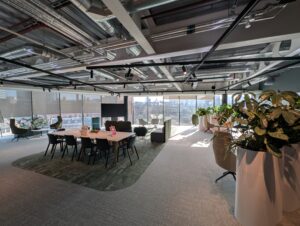Sustainable housing developments should have more environmentally-friendly features ‘built-in’ rather than them relying on good resident behaviour, a new report has found.
Research conducted by the University of York found that ‘built-in’ measures are more successful at making housing developments sustainable than measures which rely on residents understanding new technology or changing their habits.
The report, based on analysis of the new Derwenthorpe housing development just outside York, also found that giving residents an equal stake in their community can help change their behaviour, reducing their community’s carbon footprint.
Deborah Quilgars, senior research fellow from the University’s Centre for Housing Policy, said: ‘Our report showed that resident satisfaction was highest with regard to the design of the properties, which included high ceilings, large windows, potential to extend, and specially designed properties for those with disabilities and other health conditions.
‘Green outdoor space, including ponds, a playground and large open spaces was also something that residents valued. Our report recommends that emphasis on design, space, and aesthetics of new developments should be incorporated into government-level directives.’
Researchers from the university interviewed residents at Derwenthorpe, a development by Joseph Rowntree Housing Trust (JHRT) which aims to consciously create a socially and environmentally sustainable community.
Researchers also used an environmental footprint calculator to understand residents’ individual carbon footprints across a number of areas such as power usage, travel, food, shopping and leisure.
Derwenthorpe boasts a number of features which encourage its residents to live sustainably, such as a number of public transport links and its own community garden and pop-up organic food shop.
Residents at Derwenthorpe were found to use significantly less power than the rest of York and even a wider UK sample, thanks to features built into the community such as low-energy fittings, water restrictors and a community heat and water system.
Residents also praised Derwenthorpe’s mixed-tenure layout, which combines homes for sale, social renters and shared ownership without obvious differences between its houses’ designs, thereby encouraging social cohesion.
However, the report found that some technological features weren’t being used as expected, highlighting that more work needed to be put into helping residents understand how they worked.
Residents’ individual habits relating to food and travel also proved harder to shift, with many residents unable or unwilling to change how they commuted despite schemes such as limited parking spaces to encourage use of public transport.
Those involved with the report said that that the findings will help inform policy-makers and housing developers alike when it comes to facilitating future sustainable developments.
Owen Daggett, JRHT Sustainability Manager, said: ‘The research has shown how schemes such as Derwenthorpe, with environmental and casual sustainability at their core, still have areas where they can improve.’
‘For JRHT the findings will help influence our future developments, and we hope that other housing developers can use our experience to benefit other communities across the UK.’














